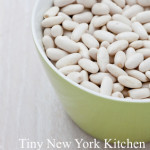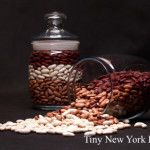Whether you’re baking summer pies or getting ready for holiday baking it’s important to have some key information about pie dough.
Blind Baking
Blind baking is prebaking a crust before you add an unbaked or especially wet filling. To ensure that your crust turns out crisp while blind baking, you can either dock it or use pie weights.
Docking
Docking is pricking the dough all over with the tines of a fork. The tiny holes allow steam to escape, so that the crust doesn’t puff up. After rolling out your dough and pressing it into the pan, gently prick it, leaving an inch or two between each mark. Be sure to check your crust several times throughout its bake time. If you notice it puffing up in any way, simply prick the puffy spots a few times and keep baking.
Pie Weights
Pie weights are tiny ceramic or metal balls or a thin metal chain that prevent the bottom of your crust from forming air pockets and bubbling up while baking. While docking is less fussy than using pie weights, I prefer pie weights because of the additional support they give the crust. Line your unbaked crust with parchment paper or aluminum foil before adding the weights to keep them from baking into the dough. I prefer parchment paper because its permeable structure allows the crust to breathe and brown more evenly. If you don’t own pie weights, dried beans work just as well.
Blind Bake Ahead
You can blind bake a crust up to three days ahead of time. Allow the crust to cool completely in the pan, wrap with plastic wrap, and store at room temperature until you are ready to fill and serve.
Happy Pie Baking!
“Work With What You Got!”
© Victoria Hart Glavin Tiny New York Kitchen © 2017 All Rights Reserved
Cannellini beans, which are widely used in Italian cooking, actually originate from Argentina.
These creamy white Italian beans are slightly larger and fatter than the white haricot beans and are more like a kidney in shape. They are related to the larger French Soissons and, like them, have a fluffy texture when cooked. They are a popular addition to classic minestrone and a variety of other soups. Cannellini beans are an essential ingredient for tonno e fagioli (tuna and bean salad) and Florentine fagioli all’uccelletto, where the beans are stewed with sage, tomatoes, and garlic. They are also delicious cooked with olive oil, onion ring slices, garlic, and parsley.
I prefer to cook with dried beans rather than canned beans. I do keep a few cans of beans in my pantry, however, as they’re useful in short notice circumstances. When you purchase canned beans make sure that the ingredients do not include sugar or salt.
To cook Cannellini Beans: Sort and rinse 3/4 cup Cannellini Beans. Place in a medium-size pot with 3 cups water. Cover and bring to a boil. Reduce heat to a medium-low and cook 60 to 90 minutes until beans are soft. Add more water as needed while cooking to keep beans covered. Makes about 2 cups/4 servings.
To reduce cooking time, soak beans in water overnight in the refrigerator. Drain and throw away soaking water before proceeding.
“Work With What You Got!”
© Victoria Hart Glavin Tiny New York Kitchen © 2016 All Rights Reserved
Dried Beans
Purchase dried beans from a source with good turnover. When I’m travel to Tucson I love to stock up on dried beans from Native Seeds, who have a nice selection of beautiful beans (http://shop.nativeseeds.org/collections/beans) The longer the beans are on the shelf, the drier they become, and the longer they will take to cook. If you’ve ever cooked beans that just wouldn’t become tender, they were probably too old. Once you have them home, store them in an airtight container in a cool dark place.
Soaking dried beans reduces the cooking time and helps the beans hold their shape better during cooking. Although soaking isn’t necessary, the shortened cooking time cuts energy use, which is a good enough reason to soak. Spread the beans on a large baking sheet, and sort through them to remove stones or broken beans. Transfer the beans to a bowl and add enough cold water to cover by an inch or two. Let stand for 2 hours; longer will shrivel the beans. Drain before using.
For a quicker soaking method, place the sorted beans in a large saucepan, add cold water to cover, and bring to a full boil. Immediately remove from the heat and cover. Let stand for 1 hour, and then drain before using.
Cooks are divided over when to salt a pot of cooking beans. Some people believe that salting toughens the beans and thus lengthens their cooking time. Others believe that if beans are salted toward the end of cooking, the flavor is dull. So, in the interest of proper seasoning, go ahead and add a reasonable amount of salt at the beginning of cooking (about 1/2 teaspoon per cup of dried beans), as the add cooking time is minimal.
www.tinynewyorkkitchen.com
“Work With What You Got!”
© Victoria Hart Glavin Tiny New York Kitchen © 2016 All Rights Reserved









